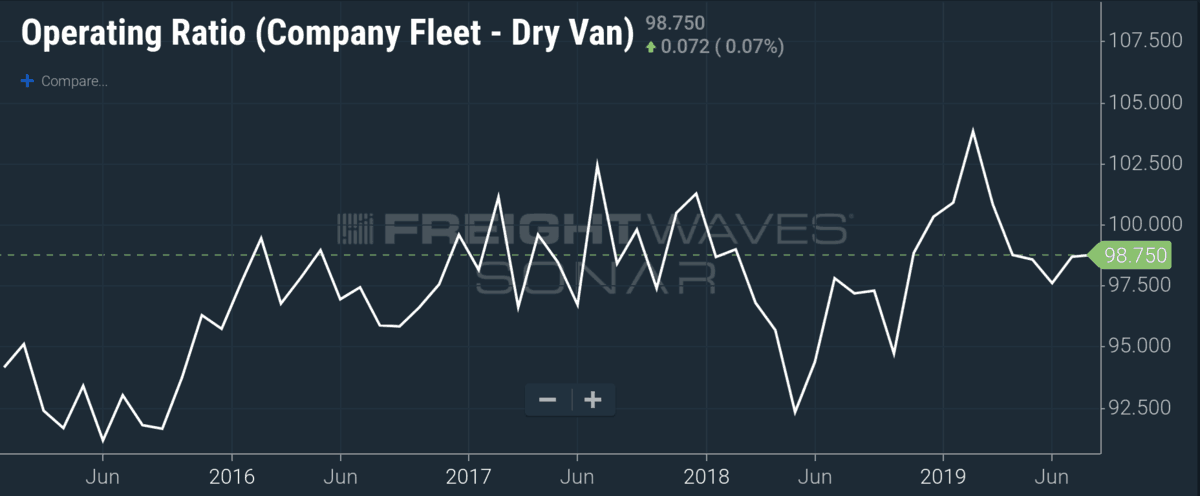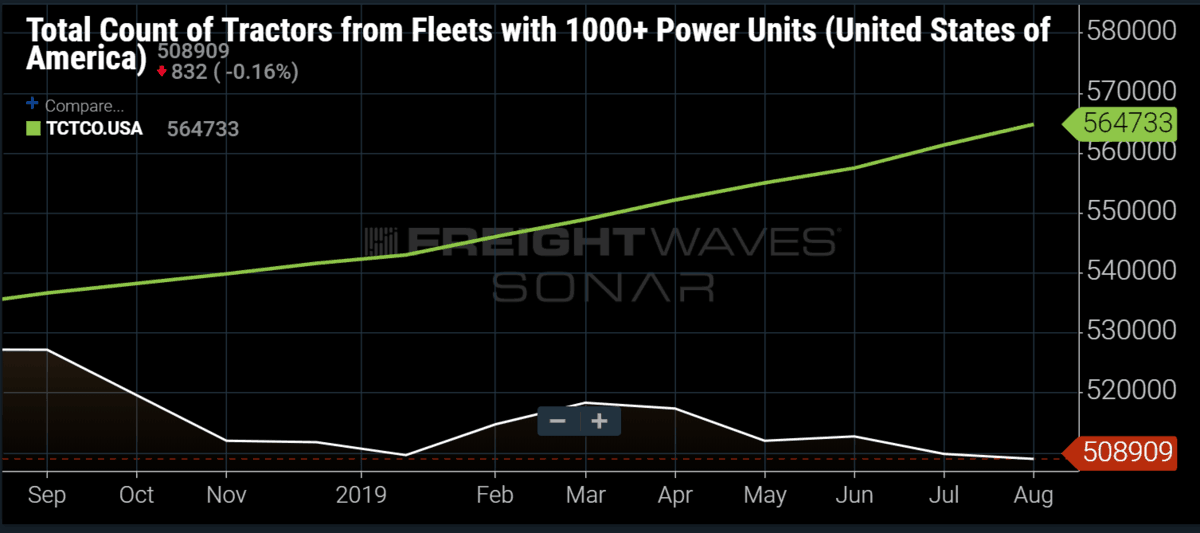
Chart of the Week: Operating Ratio — Dry Van Carriers Company Fleet (SONAR: OPRAT.VCF)
Like travelers walking through the desert that found an oasis, carriers found a wellspring of freight in 2017 and 2018 and expanded their operations. Unfortunately for the carriers, the pool has dried, leaving many dying of thirst. 2019 has been a lesson in how trucking markets can overheat just like the economy, leading to an uncomfortable period of contraction. Operating ratios (ORs) for dry van carriers in the Truckload Carriers Association (TCA) Truckload Indexes program have averaged over 100% since the start of the year as a result of this contracting growth.
In recent weeks there has been a lot of dispute in the media and over Twitter about the state of the trucking market. We’ve described the market as getting “bloody” earlier this year, while others have talked about how “strong” the trucking business is. Recently, we developed a view that the market was about to turn for the better, based on volume data we have seen in the market.
Regardless of the words you use, it is important to inform these views with data. The TCA benchmarking program is the first and only program in the history of truckload that provides monthly benchmarking of hundreds of competitive truckload carriers, ranging from mid-size to enterprise (smallest fleet 75 trucks, largest is 7000). In total, 73,000 trucks are counted in the data sample, representing 8% of the total truck count of medium and large trucking fleets operating in the entire U.S.
The fleets submit monthly financial data into a benchmarking software program that compiles aggregated financial reports for the industry, sliced by a number of variables. While the truckload carriers submit 500+ points of data, only 31 are published in an aggregated basis inside of SONAR. With this data we can use data and not bias to determine how the industry as a whole are doing. Prior to the data being offered on an aggregated basis, the only data points non-insiders would get about the state of the market is through the public truckload carrier earnings reports that would come out quarterly and offer up 8-10 operational KPIs. Now we have over 30 and they come up out monthly from over 200 different fleet profiles.
Operating ratios are a measure of operational efficiency. The formula is operating costs/operating revenue. A 100 OR indicates that for every dollar made in revenue, 100% of it goes to funding the cost of doing business, leaving nothing for debt or investment. In trucking operating costs are things like driver wages, back office support, and maintenance costs. Debt and interest payments are not included in these costs.
Most carriers carry some amount of debt in order to fund some of their growth as many trucking companies are low on cash. Purchasing equipment and buildings are some of the more commonly financed items. In general, many carriers consider making five to ten cents on the dollar a success, or a 90 to 95 OR.
The issue for carriers in 2019 has been more about the oversupply than the lack of demand, although both are present. As carriers saw margins expand in 2018, they decided to invest in growing their fleets as was demonstrated by the record number of class 8 truck orders last year. About the time that most of the orders were being placed the market started to cool. Daily truckload volumes have averaged roughly 3% under 2018 from March through July, but the most brutal hit came in May and June when they were over 4% under previous year volumes.
So far in 2019 over 600 trucking companies have reportedly failed with two larger carriers closing this week. The first carrier, HVH transportation, was owned by a private equity firm and had over 300 trucks. The second was a smaller 100 power unit operation in Georgia.
The trucking industry is extremely competitive with relatively low barriers to entry. All it takes is a commercial driver’s license (CDL), a truck, and a willingness to drive to start a trucking company. Many drivers will quit larger operations to start their own venture after a time. FreightWaves has studied the Federal Motor Carrier Safety Administration (FMCSA) data and found that smaller fleets are still growing when the lager fleets (100+ trucks) have contracted over the past several months.

Many of these drivers have developed relationships with shippers over the years, making them a reliable option. Smaller carriers have lower overhead costs and can drop rates under the larger carriers whose costs are filled with building leases and back office costs. The influx of smaller carriers has a deflationary impact to both spot and contract rates.
In 2017, carrier ORs averaged 99%. Many of the contracted rates were made based on 2016 activity, which was the last freight recession. Seeing as most freight contracts are made on an annual cycle, these rates were in place throughout most of 2017 and early 2018, which kept profit margins low.
Late in 2017 into early 2018, carriers started falling out of their contracted obligations to service higher paying spot market freight. Demand grew so fast that spot rates were well above contract. Carriers, at times, could get more than double the price of hauling for their contracted shippers. The spread between spot and contract was too much to ignore.
Recently, volumes have recovered but have not had significant impact to rates. This should provide relief for some carriers and extend their life for a time, but winter is coming when freight volumes typically plummet. Carriers normally build reserves in the summer to keep them afloat during the slower months. The true test of carrier resolve has yet to come.
About the Chart of the Week
The FreightWaves Chart of the Week is a chart selection from SONAR that provides an interesting data point to describe the state of the freight markets. A chart is chosen from thousands of potential charts on SONAR to help participants visualize the freight market in real-time. Each week a Market Expert will post a chart, along with commentary live on the front-page. After that, the Chart of the Week will be archived on FreightWaves.com for future reference.
SONAR aggregates data from hundreds of sources, presenting the data in charts and maps and providing commentary on what freight market experts want to know about the industry in real time.
The FreightWaves data science and product teams are releasing new data sets each week and enhancing the client experience.
To request a SONAR demo click here.








Steve
Trucking is becoming a joke. Its what you call a cut throat business. Brokers want to keep all the money, under pay drivers and hiring tons of office clerk that serves no purpose.
Then you have truck drivers know nothing about the business all they know they’re getting paid more than there 9-5 job, so the industry take advantage of this..
Bottom line who’s to be blame?? If you ask me truckers with lack of knowledge. We need to unite and become educated before getting into this business.
You cant be treated bad if you don’t allow it..
“ emancipate yourself from mental slavery”
Just saying; hopefully I shed some light to ones darkness.
Jamieson
They moved the trailer parks to the truck stop !
Kelvin
The truck and industry is the maze most of the people buy a truck to live better but how can you live better when the trucking companies are taking all the money in the container business you take a container to Atlanta and bring one back for $800 shouldn’t be 800 going and coming in the dump truck business they rent your truck for $75 an hour that’s man and truck shouldn’t that be $120 an hour for $160,000 piece of equipment is that funny
John
There is a problem in the Truckin industry! Why are multiple companies going under after more than 30 years in business and some have over 100 drivers ! Read people read! Hundreds have went under!
John
How come the media is the only people that seem to think that there’s a problem with the trucking industry. Every company I know of is seeking drivers it is nowhere near fully staffed. I just landed a job making more money than I thought possible driving a CDL and it’s not in an oil field in the company needs more people to drive. All of this recession vs is nothing but a hoax!
Andy Paradise
If tariffs on Chinese imports are putting you out of business, I think you need some soul searching…..
I applied for my authority (MC746584) back in 2011. Can anyone tell me why in 2019, we’re already well into the 7 digit MC numbers being issued?
Jamieson
If you have a heart beat and can follow a gps they will give you a authority! No English required
Amadou Aliou Sane
Bonjour
Je m’appelle Amadou Aliou Sane je suis sénégalais et je vie actuellement au Sénégal je cherche du travail comme chauffeur tout catégorique j’ai un permis de conduite transport en commun voilà .
David j. Corbin
I sold my two trucks 14 yrs.ago.I diversified my cdl and learned to operate heavy equipt.I was amazed at how the average joe took home more dough than me certainly had more time with family.Though I miss driving I continue to look for the economy to get better so I can jump back in.with the new china tarrifs I really dont see it happening.i remember 100s of mattel loads made in china.endless American companies made in china.o/o got nothing coming.as far as I can see.